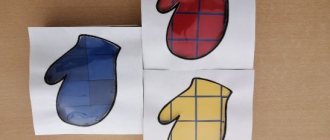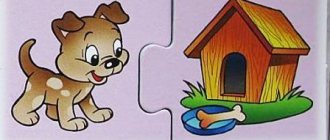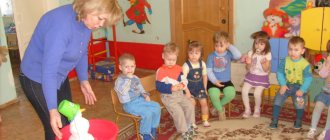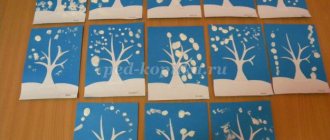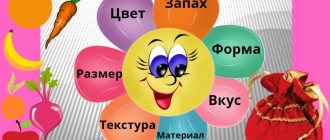Lesson on speech development in the younger group: memorizing the poem “Once upon a time there were bunnies”
Topic: “Learning the poem “Bunnies” using a mnemonic table”
Target:
Teach children to recite a poem by heart with intonation and expressiveness.
Tasks:
- help children understand the content of the poem, its emotional mood; convey its joyful character in independent reading through intonation.
- teach children to hear, listen, remember and reproduce the text of a poem, using text visualization techniques with the help of: play motivation, movements through the text, repeated reading of the text (by the teacher and children);
- learn to retell the text of a poem based on a mnemonic table.
Material:
mnemonic table, bunny toys, 2-3 artificial Christmas trees, audio recording with the song “Sunny Bunnies”.
Progress of the lesson
. Guys, look, we have guests. It's bunnies! They are so good, but very sad. Let us calm and console them. Pet the bunnies, calm them down, cheer them up.
(Children pet bunnies and say soothing words).
Somehow the bunnies are still sad, don’t smile, don’t play. How can we cheer them up?
(Children suggest how to cheer up the bunnies).
-Let’s give the bunnies a funny poem. But to do this, the poem must be learned by heart. Do you guys agree?
- Then sit down on the chairs, and the bunnies will sit next to me, and listen carefully. The teacher reads a poem:
“Once upon a time there were bunnies at the edge of the forest. Once upon a time there were bunnies in a little white hut. We washed our ears, we washed our little paws. The bunnies dressed up and put on slippers.”
— Did you guys like the poem? Who is the poem talking about? (Children answer).
— About cheerful and neat Bunnies.
I have pictures about these Bunnies, they will help us remember the poem quickly and easily. (I read the first line of the poem and show which picture each word belongs to
)
.
- And now I will show the pictures, and you, all together, will repeat this line of the poem.
(I read the second line of the poem and shows the second row of pictures).
- Please repeat this line, boys... and now girls.
(I show the third row of pictures, read the next line).
- Repeat this line, only in a quiet voice.
(shows the fourth row of pictures, finishing the poem).
- Repeat this line in a loud voice. - Now, guys, I will turn you into bunnies. Turn around yourself
turn into bunnies. You have grown long ears, short tails, paws in front of you, bent at the elbows. Jump after me to the forest edge and repeat the poem.
“Once upon a time there were bunnies at the edge of the forest. (Children jumping)
Once upon a time there were bunnies in a little white hut.
(Children squat and make the roof of the house with their hands)
They washed their ears, washed their little paws.
(Children wash their ears, wash their paws)
Bunnies dressed up and put on slippers.
(Imitate movements)
- Well, it’s time to return to our bunnies.
Turn around yourself
turn into girls and boys. — Our guests were very interested in watching you. You are very cheerful and playful kids. — I propose to cheer up the bunnies. Tell them a poem, and the pictures will help you tell it without making mistakes. You just need to tell it kindly, cheerfully, playfully, and with kindness.
- Which of you wants to please the bunnies? Masha, which bunny will you take?
(Children take turns taking toys and reading a poem for them).
- Oh! The bunnies smiled!
— Our bunnies are in a good mood, they are smiling. And when the mood is good, you want to sing and dance. Children take toys. They dance with them to the song “Sunny Bunnies”.
F - B
F - B
Unconventional ways of learning poems
Before learning a poem, you need to do some preliminary work. It involves introducing children to objects and phenomena that correspond to the content of a work of art.
The methodology for memorizing a poem in class includes the following structural components: preparing children to perceive the poem; expressive reading of a poem by a teacher (2 times); conversation on the content of the poem; repeated reading of the poem by the teacher (third time); reading a poem by children.
To facilitate the memorization of poetic works, you can use auxiliary methods, including non-traditional memorization techniques.
1 way.
Method of illustration.
Even K. D. Ushinsky wrote “Teach a child some five words unknown to him - he will suffer for a long time and in vain, but connect twenty such words with pictures, and he will learn them on the fly.”
It has been proven that in preschool age visual-figurative memory predominates and memorization is mainly involuntary. Children's memory has an amazing property - exceptional photographic ability. The visual image preserved in the child after listening, accompanied by viewing the drawings (the action of involuntary attention and involuntary visual memory), allows you to remember the poem much faster.
This method involves establishing a semantic connection between a word or sentence and a picture. The picture helps the child understand the meaning of the poem, remember key rhyming words, keeping the sequence of actions and events.
According to this method - the method of illustrations, the content of one, two or four lines of a poem is indicated by a certain picture that most clearly reflects this description.
For children in the senior group, the selected verses are depicted in 4-5 pictures, for children in the pre-school group – 7-8.
Let’s show this using the example of L. Sorokin’s poem “The clubfooted bear hears...”
Method 2.
Learning poetry in motion.
Using this method, the teacher expressively reads the entire text, and then offers to act it out, depict it in motion. For example, “The sun is shining (we draw a large circle in the air with our hands, and we depict a smile on our face), the leaves are whispering (we put our hand to our ear, as if listening to the whisper), etc. The teacher shows what movements the children will make in response to the words of the text. (You can come up with movements yourself or the children). Children, together with the teacher, pronounce words and perform movements.
Or, in another way, the teacher invites the child to take a large thick thread and “wind a ball out of the poem.” Together with him, rhythmically, we seem to “wind” line by line onto a “reel” in our head. Reeled in? And now we tell it again and unwind it, and then rewind it again. Then we hide the arms together with the ball behind the back and “wind it up for fun.” The main principle here is that we give a kinesthetic child (that is, one who needs not only to look, but also to touch) the support necessary for memorization - we reinforce the memorization with a motor act. As a variation of this method, you can invite your child to place marbles in the dish. Stitch the ball, and then take it out one at a time and put it back in again. Or string beads on a thread.
